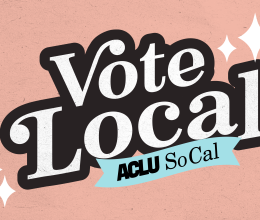
Above: Tents on the street in downtown L.A. last year.
With L.A. in a housing crisis, the ACLU/SC and other groups that represent low-income residents are fighting a downtown developer who wants to evade the city's affordable-housing rules.
"The law of the highest bidder will be a nightmare for this city, not just for its poorest residents but for the middle class struggling to hang on," said ACLU/SC staff attorney Peter Bibring. "A clean, safe apartment shouldn't just be a dream for Los Angeles residents, it should be a basic right."
G.H. Palmer Associates sued the city in February over its 15-year-old plan to increase affordable housing in the Central City West area of downtown. The ACLU/SC, Legal Aid Foundation of Los Angeles, and Western Center on Law and Poverty seek to intervene in the lawsuit on behalf of two groups that represent low-income residents and non-profit developers: the Association of Community Organizations for Reform Now and the Southern California Association of Non-Profit Housing.
At issue are L.A.'s "inclusionary zoning" rules, adopted in 1991 and intended to help replace affordable apartments lost to redevelopment in the heart of the city. The law requires developers to devote 15% of their apartments to people who make less than $40,000 a year, or to help make such housing available elsewhere. Similar rules are in effect at 33 redevelopment areas scattered throughout the city.
Low- and middle-income Angelenos face an affordable-housing squeeze, according to the filing. The average two-bedroom L.A. apartment costs $1,426. The national norm for rent is 30 percent of a couple's income, and an L.A. family would need to earn $57,040 to afford the city average. A couple earning minimum wage would need to work more than 70 hours a week each.
Between 2001 and 2006, the City lost nearly 11,000 affordable-housing units due to condominium conversions of rent-stabilized units and other reasons, and has been unable to replace them at the same rate. The city replaced less than 10 percent of needed units during that period.
Since 1974, more than 120 cities and counties throughout California have adopted inclusionary zoning ordinances as an effective means of addressing the critical shortage of affordable housing.






